Woodpeckers are fascinating creatures that come in many different shapes and sizes. In fact, there are approximately 240 different species of woodpecker alive today! These birds can range in size from the three-inch bar-breasted piculet to the 2-foot-long imperial woodpecker. Woodpeckers are also very interesting because they have unique physical adaptations that allow their body to withstand the repetitive forces of their characteristic pecking behavior. This article will explore what makes woodpeckers such unique birds and will introduce three recently extinct members of the family.
What are woodpeckers?
Physical Description
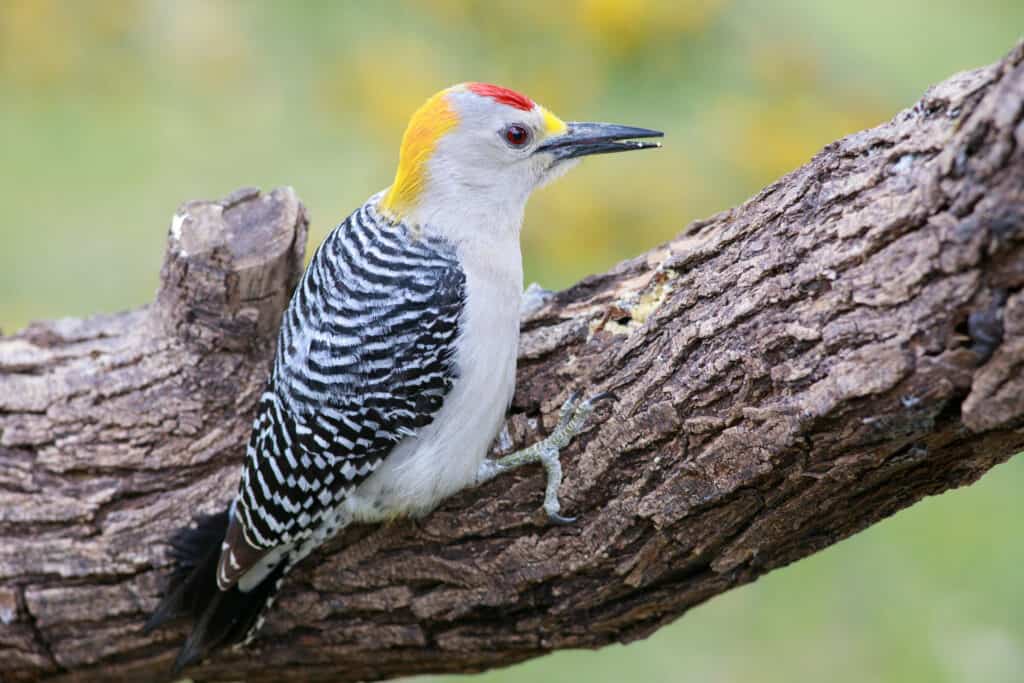
A Golden fronted woodpecker on a tree. This species is not endangered.
©Raul Baena/Shutterstock.com
Woodpeckers are members of the family Picidae within the bird class Aves. Members of this family vary dramatically in size and coloration. Many woodpeckers have fairly neutral coloring, such as the smoky-brown woodpecker, while others have very elaborate plumage, like Kaempfer’s woodpecker.
Within the family of woodpeckers, there are three subfamilies: the piculets, wrynecks, and the true woodpeckers. Piculets are smaller than other woodpeckers and have shorter beaks. Like all woodpeckers, they have large heads in proportion to their bodies and long tongues they use for capturing insects hidden in tree bark. Wryneck woodpeckers earn their name because they can rotate their head nearly 180 degrees! They have cryptic patterns on their feathers that allow for effective camouflage. Similar to piculets, they have shorter beaks than true woodpeckers. Some woodpeckers, including some true woodpeckers and some wrynecks, have zygodactyl feet. Zygodactyl feet are those that have 4 or 5 toes with two facing forward and two facing backward. Zygodactyly occurs in some bird species and chameleons.
Geographical Distribution and Habitat

Woodpeckers primarily live in woodland type habitats
©iStock.com/Kathy Byrd
Woodpeckers live around the world except in Madagascar, Australia, New Zealand, New Guinea, and the North and South poles. True woodpeckers live throughout this geographic distribution. Piculets live across tropic regions in Southeast Asia, Africa, and in South America. Wrynecks live only in Europe, Africa, and Asia. All woodpeckers live primarily in wooded habitats including woodlands, bamboo forests, savannahs, and scrublands.
What are the official conservation status classifications?
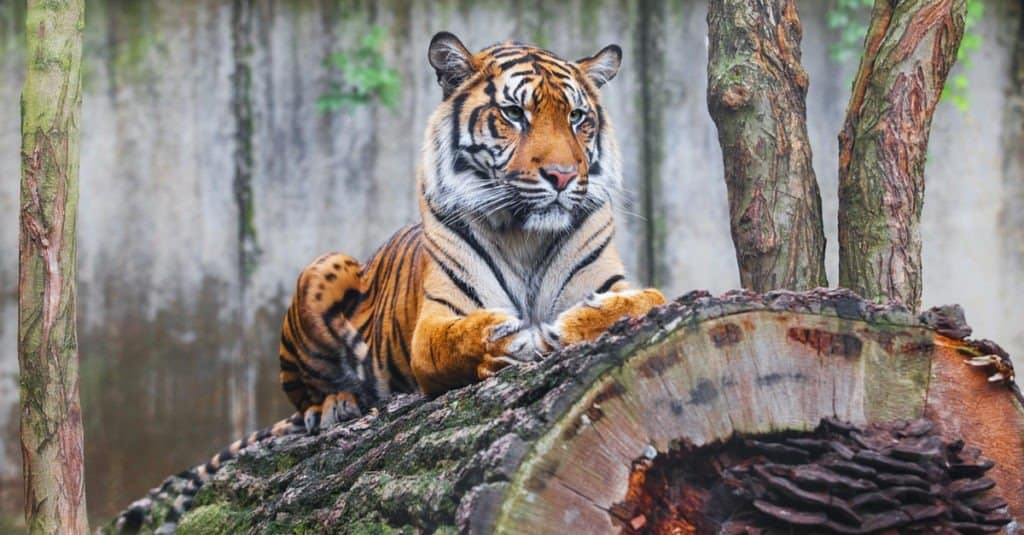
The
Sumatran tiger
is an example of a critically endangered species
©Marten_House/Shutterstock.com
The conservation statuses of various animal and plant species are assessed by the International Union for the Conservation of Nature (the IUCN) and added to their “Red List”. The IUCN evaluates different species and assigns them to one of the following categories on the IUCN Red List: data deficient, least concern, near threatened, vulnerable, endangered, critically endangered, extinct in the wild, and extinct. These categories are distinguished by a set of criteria that grade the level of endangerment of a species. Animals and plants at the lowest risk for extinction are “least concern” and those at high risk are “critically endangered”. The IUCN also tracks if certain populations are trending upwards or downwards in total size. With this in mind, let’s meet three woodpeckers that are currently moving about these categories.
Okinawa Woodpecker
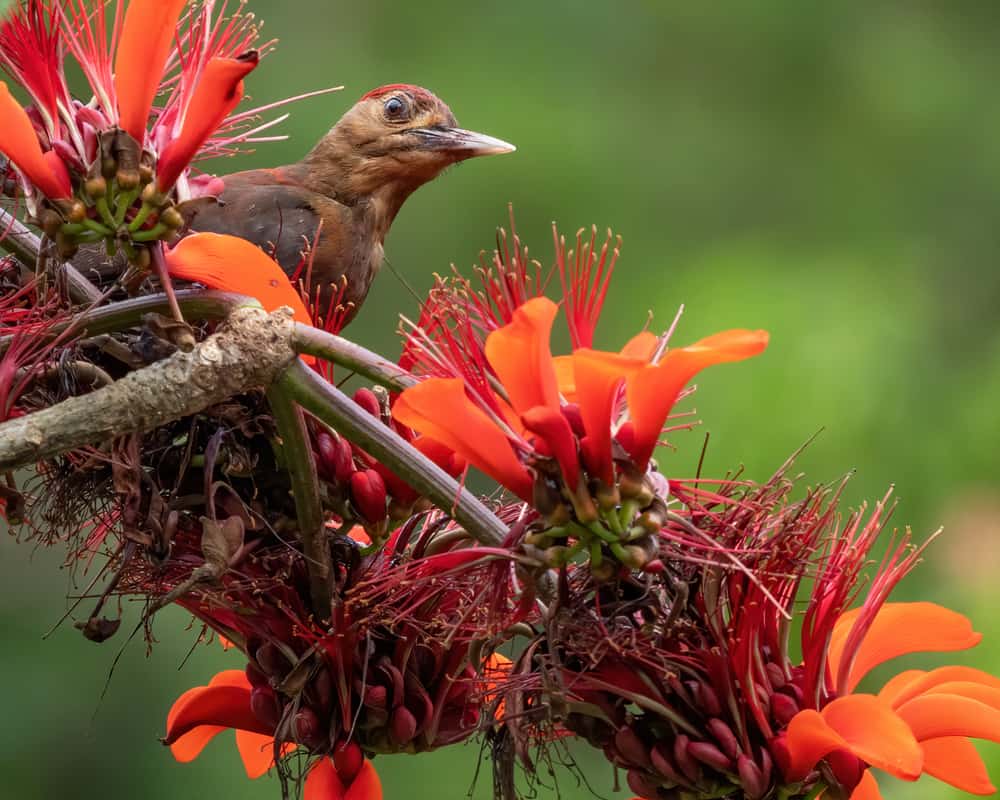
Critically endangered Okinawa woodpecker feeds on some beautiful red leaves.
©Richard Cook/Shutterstock.com
Conservation Status
One recently extinct woodpecker is the Okinawa woodpecker, which has the binomial name Dendrocopos noguchii. The IUCN currently classifies this species as critically endangered, however this classification relies on data from 2013 and many scientists regard the Okinawa woodpecker as extinct. Any remaining individuals are facing the threat of habitat destruction due to the construction of 6 American military helipads in the bird’s native Yanbaru forest in Japan. They also are in put in danger by the frequent flights of V-22 Osprey military aircrafts in the area. Their forests also endure intense logging. There are possibly as few as 50 individuals remaining in the wild, if any at all.
Description
The Okinawa woodpecker has dark brown feathers with red tips. The male bird has a red crown on its head, exemplifying sexual dimorphism. Sexual dimorphism describes when males and females of the same species have distinctly different physical characteristics. This most often due to sexual selection which is when there is competition amongst one sex of a species for access to mates.
Imperial Woodpecker

Imperial woodpeckers are believed to be extinct
©Alla Mironova/Shutterstock.com
Conservation Status
Another recently extinct woodpecker species is the imperial woodpecker (Campephilus imperialis). This woodpecker is currently critically endangered according to an IUCN assessment in 2020 but is widely recognized as most likely extinct. The decline of this species and probable extinction is made worse due to their specific breeding requirements. Each breeding pair requires 10 square miles of untouched mature forest. Deforestation and habitat destruction therefore had detrimental effects on the species’ ability to recover population numbers naturally in the wild. If any population of imperial woodpecker remains, they would number fewer than 50 individuals living in Mexico.
Description
The imperial woodpecker is the largest woodpecker to ever live! It can grow up to 22 to 24 inches long from head to tail! They have black heads and primarily black feathers across their bodies with some white on their wings. Males have a vibrant red streak on their heads that distinguish them from females.
Ivory-Billed Woodpecker
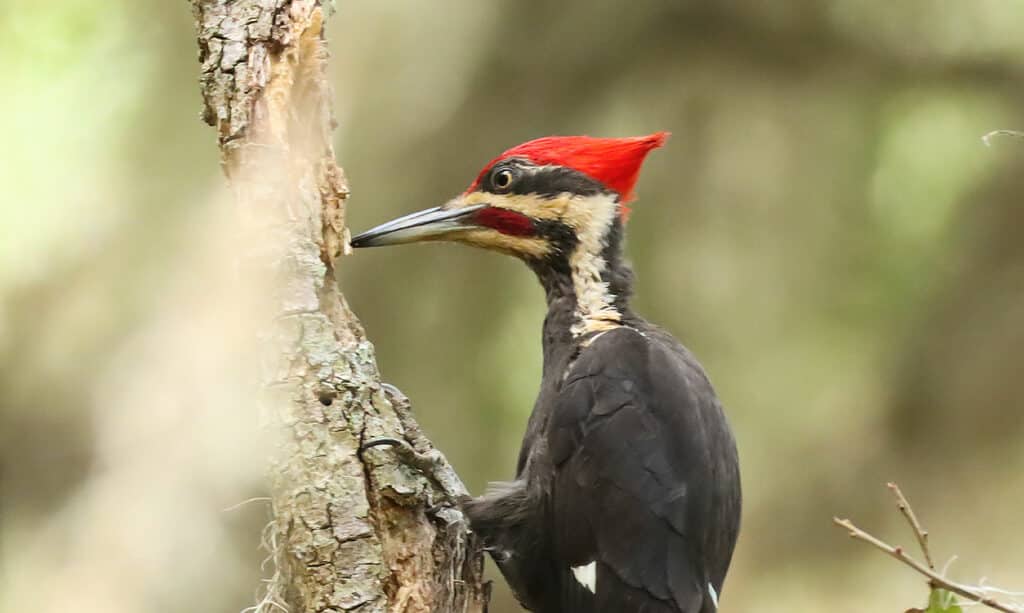
An
ivory-billed woodpecker
male with a bright red crown
©iStock.com/Wirestock
Conservation Status
The ivory-billed woodpecker (Campephilus principalis) was officially classified as extinct in 2021, but there is still some controversy in the scientific community. The IUCN currently classifies this bird as critically endangered as of 2020, the American Birding Association classifies it as “definitely or probably extinct”, and recently the U.S Fish and Wildlife Service declared the species extinct in 2021. The most recent widely agreed upon sighting of the bird was in 1944 in northeast Louisiana. The primary threats that lead to the likely extinction of the ivory-billed woodpecker were logging in their preferred wooded habitats and hunting pressures.
Description
The ivory-billed woodpecker is the largest woodpecker in North America and is the third largest woodpecker in the world. It can grow up to 20 inches long! They were closely related to the imperial woodpecker and had many shared physical characteristics. The ivory-billed woodpecker’s feathers were primarily a shiny black color with a slight purple tint. They had white streaks along the sides of their neck that converged on their back. There were also white feathers visible on their wings and males had a bright red crown.
Fun Facts About Woodpeckers
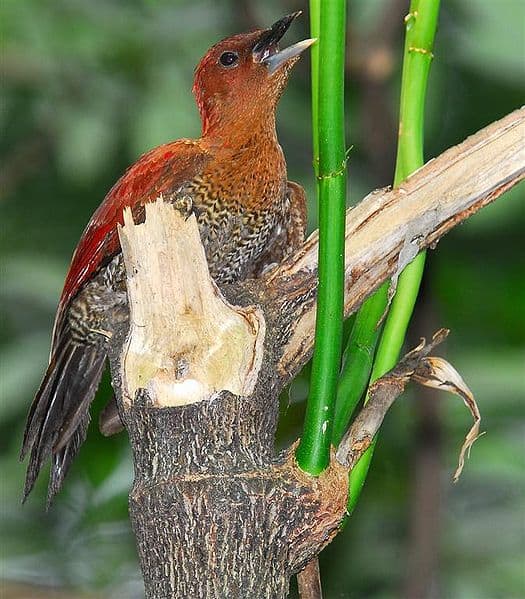
A banded woodpecker (
Picus mineaceus) performing a mating call
- Woodpeckers have long tongues that wrap around their brains! This adaptation evolved as a response to the repetitive stresses of pecking on the brain and skull.
- Interestingly, although most woodpeckers are arboreal, here are some ground-dwelling species that burrow into holes in the ground for shelter. For example, the ground woodpecker.
- Another fun fact is each species of woodpecker has a distinct drumming pattern they use as a form of nonverbal communication. They strike their bill repeatedly on a hard surface with varying rhythms and number of beats. These behaviors are primarily for territorial purposes.
- Research on woodpeckers has also been applied to scientific understandings of brain trauma, concussions, and long-term participation in contact sports. They have found that the accumulation of a certain protein, Tau protein, is involved with stabilizing the brain and when malfunctioning, relates to increasing risk of chronic traumatic encephalopathy.
Summary of 3 Recently Extinct Woodpecker Species
| Name | Year of Extinction | Location |
|---|---|---|
| Okinawa Woodpecker | IUCN: critically endangered in 2013, but considered extinct. | Japan |
| Imperial Woodpecker | 2021 | Mexico |
| Ivory-billed Woodpecker | 2021 | North America |
The photo featured at the top of this post is © Leo's Book Club/Shutterstock.com
Thank you for reading! Have some feedback for us? Contact the AZ Animals editorial team.






